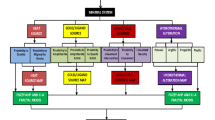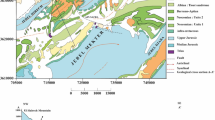Abstract
In geochemistry, the elevated concentrations of certain elements in rock or mineral samples are used for the assessment of a mineralising system’s important geological characteristics. The relationship between the elements and system characteristics may take one of two forms, regression or classification. The collection and analysis of geochemical samples typically leads to the development of sparse and fuzzy multivariate datasets, which often have complex interrelationships. As a result, it is difficult to quantitatively and qualitatively interpret many of these geochemical datasets and relate the resulting data to relevant geological characteristics. There are no governing expressions in the current literature that can relate mineral-based trace element assemblages to geological characteristics. In this work, a generalised formulation for multivariate systems modelling is presented and it is applied to the discovery of the manifested system characteristics of arsenopyrite samples collected from Australian gold (Au) deposits, using fuzzy arsenopyrite trace element datasets. Arsenopyrite trace element assemblages, collected using laser ablation-inductively coupled plasma-mass spectrometry, are represented as spatially distributed networks embedded in \( {\mathbf{R}}^{4,1} \) conformal geometric algebraic space. The interactions of elements within these networks generate multivectors which are referred to as hyperfields. The functions and parameters used to generate these hyperfields are optimised to create multiple unique models, which are used to discover relationships between system characteristics and the multivariate dataset. The models generated allow a specialist to discover qualitative relations, using higher-dimensional representations of multivariate data. In this work, the generalised hyperfield formulation is applied to the problem of predicting the endowment, lithology and camp of Au deposits, using an arsenopyrite trace element dataset. The hyperfield formulation is compared against the state-of-the-art random forest decision tree algorithm ‘XGBoost’ and artificial neural networks (ANNs).















Similar content being viewed by others

References
Abadi M, Barham P, Chen J, Chen Z, Davis A, Dean J, Devin M, Ghemawat S, Irving G, Isard M, Kudlur M (2016). Tensorflow: a system for large-scale machine learning. In: 12th Symposium on operating systems design and implementation, pp 265–283
Akay M, Cohen M, Hudson D (1997) Fuzzy sets in life sciences. Fuzzy Sets Syst 90:219–224
Bayro-Corrochano E (2018) Geometric algebra applications, vol 1. Springer, Berlin
Belcher RW (2004) Trace element zoning in pyrite determined by PIXE elemental mapping: evidence for varying ore-fluid composition and electrochemical precipitation of gold at the Spitskop deposit, Saldania Belt, South Africa. X-ray Spectrom 33:174–180
Belousova EA, Griffin WL, O’Reilly SY, Fisher NI (2002) Apatite as an indicator mineral for mineral exploration: trace-element compositions and their relationship to host rock type. J Geochem Explor 76:45–69
Braun M, Hubay K, Magyari E, Veres D, Papp I, Bálint M (2013) Using linear discriminant analysis (LDA) of bulk lake sediment geochemical data to reconstruct late glacial climate changes in the South Carpathian Mountains. Quatern Int 293:114–122
Buduma N, Locascio N (2017) Fundamentals of deep learning: designing next-generation machine intelligence algorithms. O’Reilly Media Inc, Newton
Chen T, Guestrin C (2016) Xgboost: a scalable tree boosting system. In: Proceedings of the 22nd ACM SIGKDD international conference on knowledge discovery and data mining, pp 785–794
Cloutier V, Lefebvre R, Therrien R, Savard MM (2008) Multivariate statistical analysis of geochemical data as indicative of the hydrogeochemical evolution of groundwater in a sedimentary rock aquifer system. J Hydrol 353:294–313
Condie K (1976) Trace-element geochemistry of archean greenstone belts. Earth Sci Rev 12:393–417
Cook NJ, Ciobanu CL, Meria D, Silcock D, Wade B (2013) Arsenopyrite-pyrite association in an orogenic gold ore: tracing mineralization history from textures and trace elements. Econ Geol Bull Soc Econ Geol 108:1273–1283
Delanghe R (2001) Clifford analysis: history and perspective. Comput Methods Funct Theory 1:107–154
Diehl SF, Goldhaber MB, Koenig AE, Lowers HA, Ruppert LF (2012) Distribution of arsenic, selenium, and other trace elements in high pyrite Appalachian coals: evidence for multiple episodes of pyrite formation. Int J Coal Geol 94:238–249
Doran C, Lasenby A (2003) Geometric algebra for physicists. Cambridge University Press, Cambridge
Doran C, Lasenby A, Lasenby J (2002) Conformal geometry, Euclidean space and geometric algebra. Uncertainty in geometric computations. Springer, Boston, pp 41–58
Dubois D, Prade H (2012) Fundamentals of fuzzy sets, vol 7. Springer, Berlin
Gardner MW, Dorling SR (1998) Artificial neural networks (the multilayer perceptron)-a review of applications in the atmospheric sciences. Atmos Environ 32:2627–2636
Goldschmidt VM (1937) The principles of distribution of chemical elements in minerals and rocks. The seventh Hugo Müller Lecture, delivered before the Chemical Society on March 17th, 1937. J Chem Soc 1937:655–673
Grunsky EC, Drew LJ, Sutphin DM (2009) Process recognition in multi-element soil and stream-sediment geochemical data. Appl Geochem 24:1602–1616
Hestenes D, Sobczyk G (1984) Clifford algebra to geometric calculus: a unified language for mathematics and physics. D. Reidel, Dordrecht
Hildenbrand D (2013) Conformal geometric algebra. Foundations of geometric algebra computing. Springer, Berlin, pp 27–44
Hitzer E (2013) Introduction to Clifford’s geometric algebra. J Control Meas Syst Integr 4:1–11
Hoskin PW, Ireland TR (2000) Rare earth element chemistry of zircon and its use as a provenance indicator. Geology 28:627–630
Huston DL, Sie SH, Suter GF (1995) Trace elements in sulfide minerals from eastern Australian volcanic-hosted massive sulfide deposits. Econ Geol Bull Soc Econ Geol 90:1167–1196
Ji H, Zeng D, Shi Y, Wu Y, Wu X (2007) Semi-hierarchical correspondence cluster analysis and regional geochemical pattern recognition. J Geochem Explor 93:109–119
J.O.R.C. (2012) Australasian code for reporting of exploration results, mineral resources and ore reserves. The JORC Code
Koglin N, Frimmel HE, Minter WL, Brätz H (2010) Trace-element characteristics of different pyrite types in Mesoarchaean to Palaeoproterozoic placer deposits. Miner Deposita 45:259–280
Lawley CJ, Creaser RA, Jackson SE, Yang Z, Davis BJ, Pehrsson SJ, Dubé B, Mercier-Langevin P, Vaillancourt D (2015) Unraveling the Western Churchill Province paleoproterozoic gold metallotect: constraints from Re-Os arsenopyrite and U-Pb xenotime geochronology and LA-ICP-MS arsenopyrite trace element chemistry at the BIF-hosted Meliadine Gold District, Nunavut, Canada. Econ Geol 110:1425–1454
Laznicka P (1983) Giant ore deposits: a quantitative approach. Glob Tecton Metallog 2:41–64
Lee M, Shin D, Yoo B, Im H, Pak S, Choi S (2019) LA-ICP-MS trace element analysis of arsenopyrite from the Samgwang gold deposit, South Korea, and its genetic implications. Ore Geol Rev 114:103147
Li DC, Hsu HC, Tsai TI, Lu TJ, Hu SC (2007) A new method to help diagnose cancers for small sample size. Expert Syst Appl 33:420–424
López-Franco C, Bayro-Corrochano E (2006) Omnidirectional robot vision using conformal geometric computing. J Math Imaging Vis 26:243–260
Lounesto P, Wene GP (1987) Idempotent structure of Clifford algebras. Acta Applicandae Mathematica 9:165–173
Malonek HR, Falcao MI (2010) September. On special functions in the context of Clifford analysis. AIP Conf Proc 1281:1492–1495
Mao R, Zhu H, Zhang L, Chen A (2006) October. A new method to assist small data set neural network learning. In: Sixth international conference on intelligent systems design and applications, vol 1, pp 17–22
Mao M, Rukhlov AS, Rowins SM, Spence J, Coogan LA (2016) Apatite trace element compositions: a robust new tool for mineral exploration. Econ Geol 111:1187–1222
McKinley JM, Grunsky E, Mueller U (2018) Environmental monitoring and peat assessment using multivariate analysis of regional-scale geochemical data. Math Geosci 50:235–246
Murphy ME (2016) The trace element chemistry of arsenopyrite and its potential use as an indicator mineral for gold deposit exploration in Australia. Ph.D. Dissertation, University of Western Australia
Newman M (2010) Networks. Oxford University Press, Oxford
Nielsen D (2016) Tree boosting with XGBoost-why does XGBoost win “Every” machine learning competition? Masters Dissertation, Norwegian University of Science and Technology
Pal SK, Mitra S (1992) Multilayer perceptron, fuzzy sets, and classification. IEEE Trans Neural Netw 3:683–697
Panchal G, Ganatra A, Kosta YP, Panchal D (2011) Behaviour analysis of multilayer perceptrons with multiple hidden neurons and hidden layers. Int J Comput Theory Eng 3:332–337
Templ M, Filzmoser P, Reimann C (2008) Cluster analysis applied to regional geochemical data: problems and possibilities. Appl Geochem 23:2198–2213
Torlay L, Perrone-Bertolotti M, Thomas E, Baciu M (2017) Machine learning-XGBoost analysis of language networks to classify patients with epilepsy. Brain Inform 4(3):159
Ubide T, McKenna CA, Chew DM, Kamber BS (2015) High-resolution LA-ICP-MS trace element mapping of igneous minerals: in search of magma histories. Chem Geol 409:157–168
Wareham RJ, Lasenby J, Lasenby A (2007) Computer graphics using conformal geometric algebra. Dissertation, University of Cambridge
Yuan L, Yu Z, Luo W, Zhou L, Lü G (2011) A 3D GIS spatial data model based on conformal geometric algebra. Sci China Earth Sci 54:101–112
Zhang L, Zhan C (2017) Machine learning in rock facies classification: an application of XGBoost. In: International geophysical conference, Qingdao, China, 17–20 Apr 2017, pp 1371–1374
Zhang D, Qian L, Mao B, Huang C, Huang B, Si Y (2018) A data-driven design for fault detection of wind turbines using random forests and XGboost. IEEE Access 6:1020–21031
Zuo R (2017) Machine learning of mineralization-related geochemical anomalies: a review of potential methods. Nat Resour Res 26:457–464
Acknowledgements
This work is dedicated to the memory of the late James I. Stewart.
Author information
Authors and Affiliations
Corresponding author
Appendices
Appendix 1
1.1 Sample Node Inputs (\( \alpha_{qk} \))
Appendix 2
2.1 Prediction Results
Appendix 3: MLP Loss Functions
3.1 Endowment Loss Function
See Fig. 16.
Loss function for MLP A, for the endowment regression case study (Sect. 3.1)
3.2 Lithology Loss Function
See Fig. 17.
Loss function for MLP B, for the lithology classification case study (Sect. 3.2)
3.3 Camp Loss Function
See Fig. 18.
Loss function for MLP B, for the camp classification case study (Sect. 3.3)
Rights and permissions
About this article
Cite this article
Thiruvengadam, S., Murphy, M.E., Tan, J.S. et al. Multivariate Modelling of the Trace Element Chemistry of Arsenopyrite from Gold Deposits Using Higher-Dimensional Algebras. Math Geosci 52, 865–928 (2020). https://doi.org/10.1007/s11004-020-09856-3
Received:
Accepted:
Published:
Issue Date:
DOI: https://doi.org/10.1007/s11004-020-09856-3






